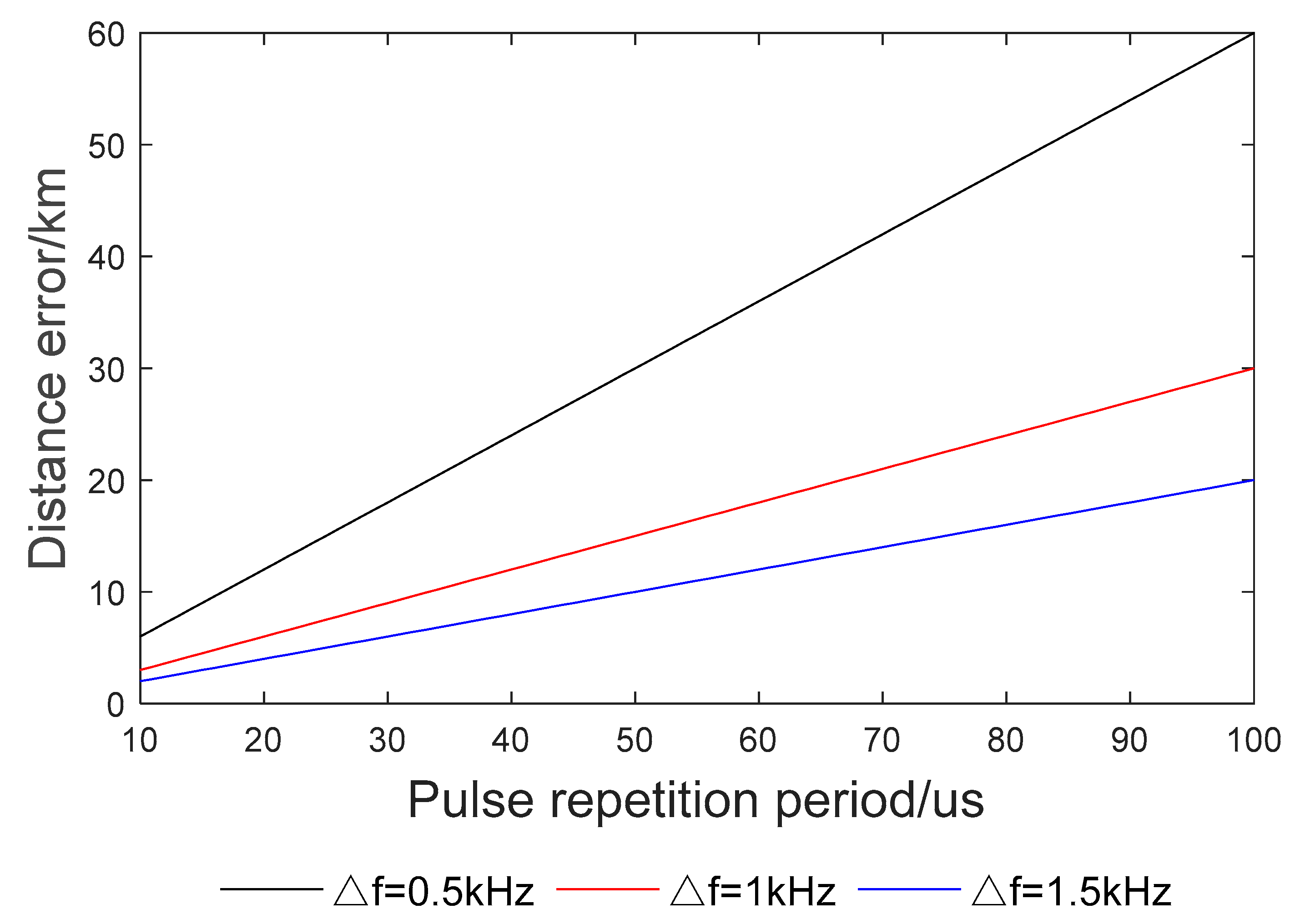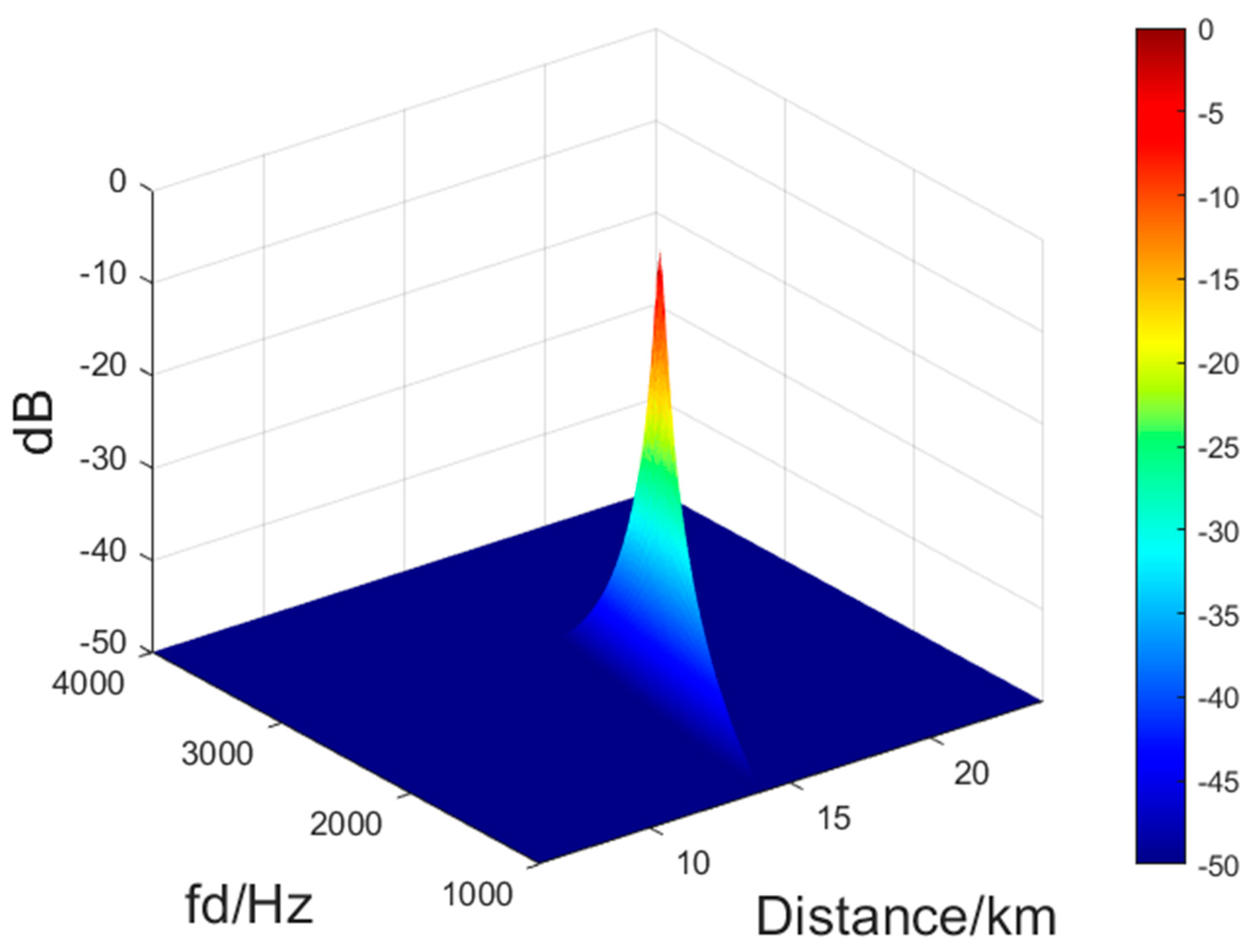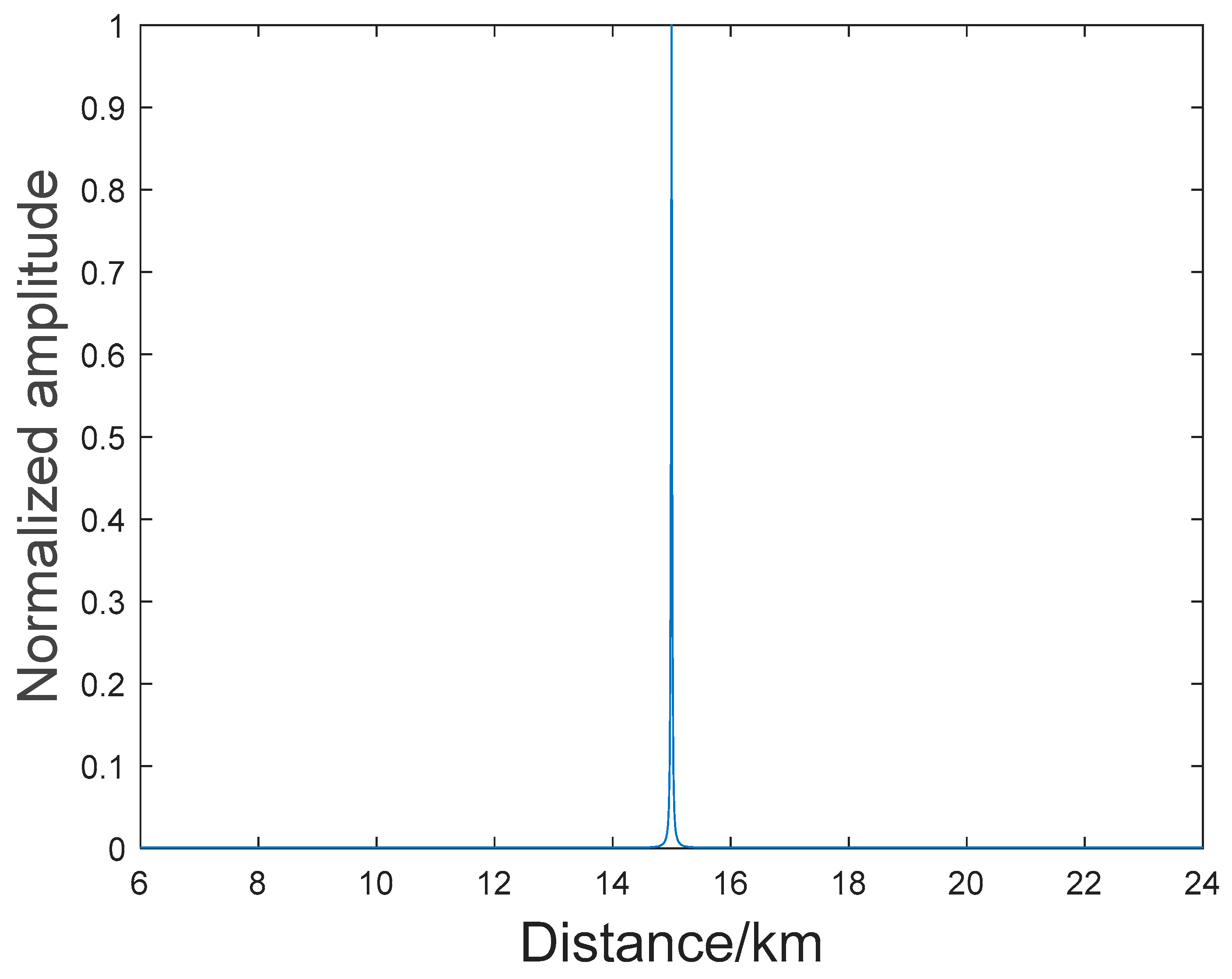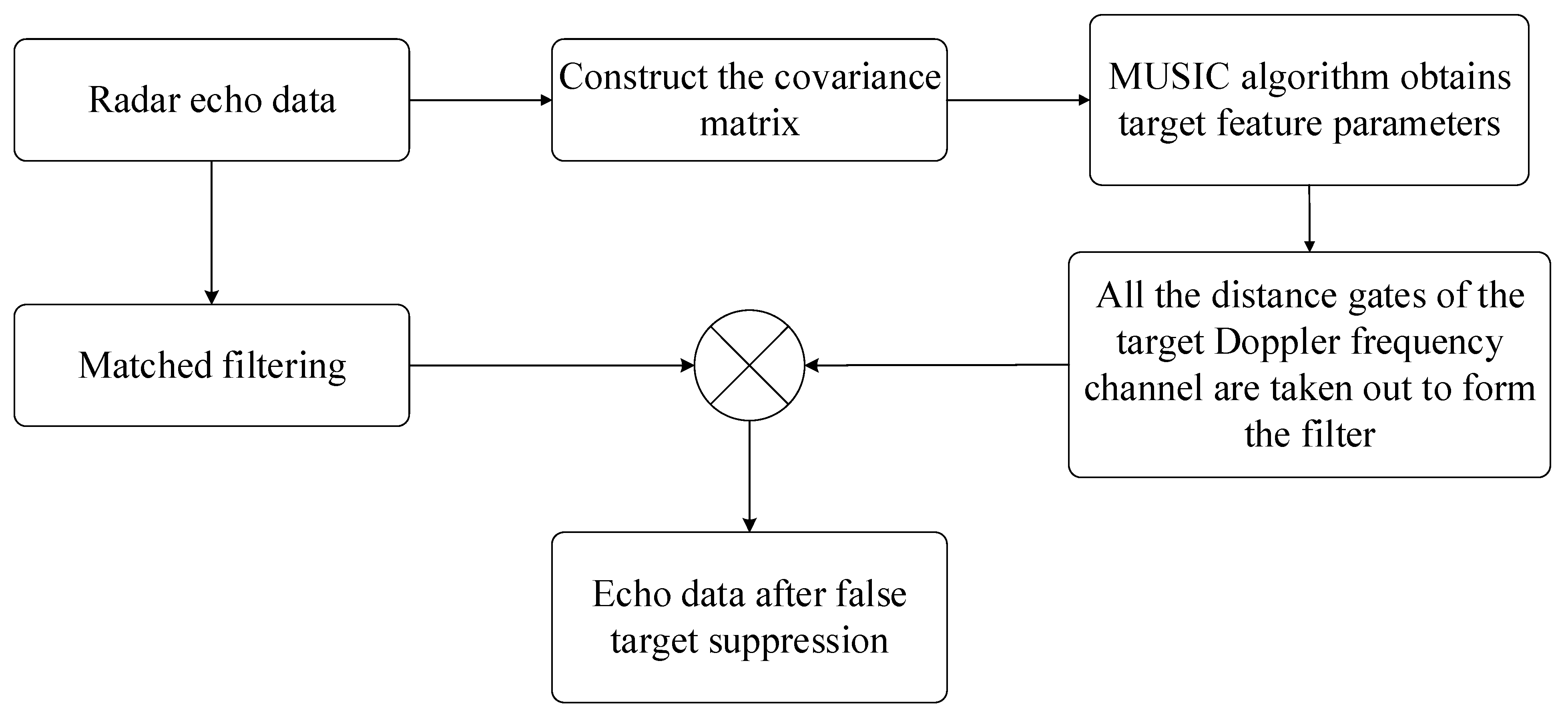A Method for Suppressing False Target Jamming with Non-Uniform Stepped-Frequency Radar
Abstract
:1. Introduction
2. Radar Signal and Jamming Model
3. Analysis of the Principle of Range-Doppler Coupling and the Necessity of Decoupling
4. Decoupling Waveform Design and False Target Suppression Method
5. Algorithm Analysis
5.1. Simulation of False Target Suppression
5.2. The Influence of Stepped-Frequency Size Algorithm Performance
5.3. Analysis of the Impact of Input SNR on Output SINR
6. Conclusions
Author Contributions
Funding
Data Availability Statement
Conflicts of Interest
References
- Liu, W.J.; Liu, J.; Liu, T.; Chen, H.; Wang, Y.-L. Detector design and performance analysis for target detection in subspace interference. IEEE Signal Process. Lett. 2023. [CrossRef]
- Hou, Y.; Gao, H.; Huang, Q.; Qi, J.; Mao, X.; Gu, C. A Robust Capon Beamforming Approach for Sparse Array Based on Importance Resampling Compressive Covariance Sensing. IEEE Access 2019, 7, 80478–80490. [Google Scholar] [CrossRef]
- Zheng, Z.; Yang, T.; Wang, W.Q.; Zhang, S. Robust adaptive beamforming via coprime coarray interpolation. Signal Process. 2020, 169, 107382. [Google Scholar] [CrossRef]
- Yang, J.; Guo, X.X.; Li, Y.J. Design of a novel DRFM jamming system based on AFB-SFB. In Proceedings of the IET International Radar Conference, Xi’an, China, 14–16 April 2013. [Google Scholar] [CrossRef]
- Li, C.; Su, W.; Gu, H.; Ma, C.; Chen, J.-L. Improved interrupted sampling repeater jamming based on DRFM. In Proceedings of the IEEE International Conference on Signal Processing, Communications and Computing (ICSPCC), Guilin, China, 5–8 August 2014; pp. 254–257. [Google Scholar] [CrossRef]
- Wang, X.; Chen, H.; Ni, M.; Ni, L.; Li, B. Radar anti-false target jamming method based on phase modulation. Syst. Eng. Electron. 2021, 43, 2476–2483. [Google Scholar] [CrossRef]
- Wang, X.S.; Liu, J.C.; Zhang, W.M.; Fu, Q.X.; Liu, Z.; Xie, X.X. The mathematical principle of intermittent sampling and forwarding interfere. Sci. China Ser. E Inf. Sci. 2006, 36, 891–901. [Google Scholar] [CrossRef]
- Zhou, C.; Liu, Q.H.; Hu, C. Time-frequency analysis techniques for recognition and suppression of interrupted sampling repeater jamming. J. Radars 2019, 8, 100–106. [Google Scholar] [CrossRef]
- Antonik, P.; Wicks, M.C.; Griffiths, H.D.; Baker, C. Multi-mission multi-mode waveform diversity. In Proceedings of the IEEE Conference on Radar, Verona, NY, USA, 24–27 April 2006. [Google Scholar] [CrossRef]
- Lin, C.H.; Fang, W.H. Joint Angle and Delay Estimation in Frequency Hopping Systems. IEEE Trans. Aerosp. Electron. Syst. 2013, 49, 1042–1056. [Google Scholar] [CrossRef]
- Oh, D.; Lee, J.H. Low-Complexity Range-Azimuth FMCW Radar Sensor Using Joint Angle and Delay Estimation Without SVD and EVD. IEEE Sens. J. 2015, 15, 4799–4811. [Google Scholar] [CrossRef]
- Wang, Y.B.; Wang, W.Q.; Shao, H.Z. Frequency Diverse Array Radar Cramer-Rao Lower Bounds for Estimating Direction, Range, and Velocity. Int. J. Antennas Propag. 2014, 2014, 830869. [Google Scholar] [CrossRef] [Green Version]
- Sun, H.L.; Gao, H.Y.; Du, Y.N.; Cheng, J.H.; Liu, Y.P. Joint estimation method of target number and orientation parameters for FDA-MIMO radar. J. Commun. 2023, 44, 41–51. [Google Scholar]
- Qin, S.; Zhang, Y.D.; Amin, M.G.; Gini, F. Frequency diverse coprime arrays with coprime frequency offsets for multitarget localization. IEEE J. Sel. Top. Signal Process. 2016, 11, 321–335. [Google Scholar] [CrossRef]
- Xu, J.W.; Liao, G.S.; Zhu, S.Q.; So, H.C. Deceptive jamming suppression with frequency diverse MIMO radar. Signal Process. 2015, 113, 9–17. [Google Scholar] [CrossRef]
- Lan, L.; Liao, G.S.; Xu, J.W.; Huang, Y. Main-beam deceptive jamming suppression with non-adaptive beam-forming in FDA-MIMO radar. J. Signal Process. 2019, 35, 944–950. [Google Scholar] [CrossRef]
- Wan, F.H.; Xu, J.W.; Zhang, Z.R. Robust Beamforming Based on Covariance Matrix Reconstruction in FDA-MIMO Radar to Suppress Deceptive Jamming. Sensors 2022, 22, 1479. [Google Scholar] [CrossRef]
- Xu, Y.; Shi, X.; Xu, J.; Li, P. Range-angle-dependent beamforming of pulsed frequency diverse array. IEEE Trans. Antennas Propag. 2015, 63, 3262–3267. [Google Scholar] [CrossRef]
- Shao, H.Z.; Li, X.; Wang, W.Q.; Xiong, J.; Chen, H. Time-invariant transmit beampattern synthesis via weight design for FDA radar. In Proceedings of the 2016 IEEE Radar Conference (RadarConf), Philadelphia, PA, USA, 2–6 May 2016; pp. 1–4. [Google Scholar] [CrossRef]
- Quan, Y.H.; Li, Y.C.; Wu, Y.; Ran, L.; Xing, M.; Liu, M. Moving target detection for frequency agility radar by sparse reconstruction. Rev. Sci. Instrum. 2016, 87, 094703. [Google Scholar] [CrossRef]
- Dong, S.X.; Quan, Y.H.; Sha, M.H.; Fang, W.; Xing, M.D. Frequency agile radar combined with intra-pulse frequency coding to resist intermittent sampling jamming. Syst. Eng. Electron. 2022, 44, 3371–3379. [Google Scholar] [CrossRef]
- Liu, Z.X.; Du, S.Y.; Wu, Y.J.; Sha, M.H.; Xing, M.D.; Quan, Y.H. Anti-interrupted sampling repeater jamming method for interpulse and intrapulse frequency-agile radar. J. Radars 2022, 11, 301–312. [Google Scholar] [CrossRef]
- Fang, W.; Quan, Y.H.; Sha, M.H.; Liu, Z.X.; Gao, X.; Xing, M.D. Dense false targets jamming suppression algorithm based on frequency agility and waveform entropy. Syst. Eng. Electron. 2021, 43, 1506–1514. [Google Scholar] [CrossRef]
- Dong, S.X.; Quan, Y.H.; Chen, X.D.; Gao, X.; Li, Y.C.; Xing, M.D. Interference suppression algorithm based on frequency agility combined with mathematical morphology. Syst. Eng. Electron. 2020, 42, 1491–1498. [Google Scholar] [CrossRef]
- Zeng, L.; Zhang, Z.J.; Wang, Y.L.; Liu, W.; Chen, H.; Zhou, B. Suppression of dense false target jamming for stepped frequency radar in slow time domain. Sci. China Inf. Sci. 2022, 65, 283–285. [Google Scholar] [CrossRef]
- Schmidt, R.; Schmidt, R.O. Multiple emitter location and signal parameter estimation. IEEE Trans. Antennas Propag. 1986, 34, 276–280. [Google Scholar] [CrossRef] [Green Version]











Disclaimer/Publisher’s Note: The statements, opinions and data contained in all publications are solely those of the individual author(s) and contributor(s) and not of MDPI and/or the editor(s). MDPI and/or the editor(s) disclaim responsibility for any injury to people or property resulting from any ideas, methods, instructions or products referred to in the content. |
© 2023 by the authors. Licensee MDPI, Basel, Switzerland. This article is an open access article distributed under the terms and conditions of the Creative Commons Attribution (CC BY) license (https://creativecommons.org/licenses/by/4.0/).
Share and Cite
Zhu, Y.; Zhang, Z.; Wang, X.; Li, B.; Liu, W.; Chen, H. A Method for Suppressing False Target Jamming with Non-Uniform Stepped-Frequency Radar. Electronics 2023, 12, 2534. https://doi.org/10.3390/electronics12112534
Zhu Y, Zhang Z, Wang X, Li B, Liu W, Chen H. A Method for Suppressing False Target Jamming with Non-Uniform Stepped-Frequency Radar. Electronics. 2023; 12(11):2534. https://doi.org/10.3390/electronics12112534
Chicago/Turabian StyleZhu, Yongzhe, Zhaojian Zhang, Xiaoge Wang, Binbin Li, Weijian Liu, and Hao Chen. 2023. "A Method for Suppressing False Target Jamming with Non-Uniform Stepped-Frequency Radar" Electronics 12, no. 11: 2534. https://doi.org/10.3390/electronics12112534




